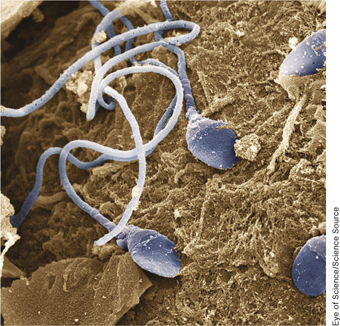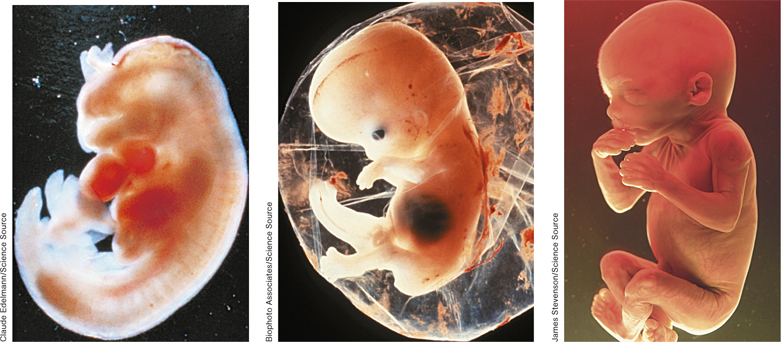10.1 Prenatality: A Womb with a View
You probably calculate your age by counting your birthdays, but the fact is that on the day you were born, you were already 9 months old. The prenatal stage of development ends with birth and begins 9 months earlier when about 200 million sperm make the journey from a woman’s vagina, through her uterus, and on to her fallopian tubes. That journey is a perilous one. Many of the sperm have defects that prevent them from swimming vigorously enough to make any progress, and others get stuck in what is essentially a sperm traffic jam. Of those that do manage to make their way through the uterus, many will take a wrong turn and end up in the fallopian tube that does not contain an egg. In fact, a mere 200 or so of the original 200 million sperm will manage to get close enough to an egg to release digestive enzymes that erode the egg’s protective outer layer. The moment the first sperm manages to penetrate the egg’s coating, the egg will release a chemical that seals the coating and keeps all the other sperm from entering. After triumphing over 199,999,999 of its closest friends, this single successful sperm will shed its tail and fertilize the egg. About 12 hours later, the egg will merge with the nuclei of the sperm, and the prenatal development of a unique human being will begin.
315
Prenatal Development
A zygote is a fertilized egg. From the first moment of its existence, a zygote has one thing in common with the person it will someday become: sex. Each human sperm and each human egg contain 23 chromosomes, and one of these chromosomes (the 23rd) comes in two varieties known as X and Y. The egg’s 23rd chromosome is always an X, but the sperm’s can be an X or a Y. If the egg is fertilized by a sperm that has a Y chromosome, then the zygote is male (XY), and if it is fertilized by a sperm that has an X chromosome, then the zygote is female (XX).
zygote
A fertilized egg that contains chromosomes from both a sperm and an egg.

The germinal stage is the 2-
germinal stage
The 2-
If the zygote successfully implants itself in the uterine wall, it earns the right to be called an embryo, and a new stage of development begins. The embryonic stage is a period of prenatal development that lasts from the 2nd week until about the 8th week (see FIGURE 10.1). During this stage, the embryo continues to divide, and its cells begin to differentiate to build the structures of the body. The 1 inch long embryo has a beating heart and other body parts, such as arms and legs. Male embryos begin to produce a hormone called testosterone, which masculinizes their reproductive organs.
embryonic stage
The period of prenatal development that lasts from the second week until about the eighth week.

What are the stages of prenatal development?
At about 9 weeks, the embryo gets a new name: fetus. The fetal stage is the period of prenatal development that lasts from the 9th week until birth. The fetus has a skeleton and muscles that make it capable of movement. It develops a layer of insulating fat beneath its skin, and its digestive and respiratory systems mature. The cells that will ultimately become the brain divide and begin to generate axons and dendrites (which permit communication with other brain cells). They also begin to undergo a process (described in the Neuroscience and Behavior chapter) known as myelination, which is the formation of a fatty sheath around the axons of a neuron. Just as plastic sheathing insulates a wire, myelin insulates a brain cell and prevents the leakage of neural signals that travel along the axon. This process starts during the fetal stage but doesn’t end for years; the myelination of the cortex, for example, continues into adulthood.
fetal stage
The period of prenatal development that lasts from the ninth week until birth.
myelination
The formation of a fatty sheath around the axons of a neuron.
316
Why are human beings born with underdeveloped brains?
Although the brain undergoes rapid and complex growth during the fetal period, at birth it is nowhere near its adult size. Whereas a newborn chimpanzee’s brain is nearly 60% of its adult size, a newborn human’s brain is only 25% of its adult size, which is to say that 75% of a person’s brain development occurs outside the womb. There are two reasons for this. First, if a newborn human’s head were 60% of its adult size (like a newborn chimp’s head is) then that newborn could never pass through its mother’s birth canal. Second, one of our species’ greatest talents is its ability to adapt to a wide range of novel environments that differ in climate, social structure, and so on. Rather than arriving in the world with a fully developed brain, human brains do much of their developing within the very environments in which they ultimately must function. The fact that our brains are specifically shaped by the unique social and physical environment into which we are born is one of the main reasons why we are so adaptable.

Prenatal Environment

The womb is an environment that has a powerful impact on development (Coe & Lubach, 2008; Glynn & Sandman, 2011; Wadhwa, Sandman, & Garite, 2001). For example, the placenta is the organ that physically links the bloodstreams of the mother and the embryo or fetus and permits the exchange of certain chemicals. That’s why the foods a woman eats during pregnancy can affect her unborn child. The children of mothers who receive insufficient nutrition during pregnancy often have physical problems (Stein et al., 1975) and psychological problems, most notably an increased risk of schizophrenia and antisocial personality disorder (Neugebauer, Hoek, & Susser, 1999; Susser, Brown, & Matte, 1999). The foods a woman eats during pregnancy can also shape her child’s food preferences: Studies show that infants tend to like the foods and spices that their mothers ate while they were in the womb (Mennella, Johnson, & Beauchamp, 1995).
How does the uterine environment affect the unborn child?
But it isn’t just food that affects the fetus. Almost anything a woman eats, drinks, inhales, injects, sniffs, snorts, or rubs on her skin can pass through the placenta. Agents that impair development are called teratogens, which literally means “monster makers.” The most common teratogen is alcohol. Fetal alcohol syndrome (FAS) is a developmental disorder caused by heavy alcohol use during pregnancy, and children with FAS have a variety of brain abnormalities and cognitive deficits (Carmichael Olson et al., 1997; Streissguth et al., 1999). Some studies suggest that light drinking does not harm the fetus, but there is little consensus about how much drinking is light (Warren & Hewitt, 2009). Tobacco is another common teratogen. Babies whose mothers smoke have lower birth weights (Horta et al., 1997) and are more likely to have perceptual and attentional problems in childhood (Espy et al., 2011; Fried & Watkinson, 2000). Even secondhand smoke can lead to reduced birth weight and deficits in attention and learning (Makin, Fried, & Watkinson, 1991; Windham, Eaton, & Hopkins, 1999). Other teratogens include environmental poisons such as lead in the water, paint dust in the air, or mercury in fish.
teratogens
Agents that damage the process of development.
fetal alcohol syndrome
A developmental disorder caused by heavy alcohol use during pregnancy.
317
What can a fetus hear?
The prenatal environment is rich with chemicals, but it is also rich with information. Wombs are dark because only the brightest light can filter through the mother’s abdomen, but they are not quiet. The fetus can hear its mother’s heartbeat, the gastrointestinal sounds associated with her digestion, and her voice. How do we know? Newborns will suck a nipple more vigorously when they hear the sound of their mother’s voice than when they hear the voice of a female stranger (Querleu et al., 1984), demonstrating that they are more familiar with the former. Similarly, newborns whose mothers read aloud from The Cat in the Hat during their pregnancies react as though the story is familiar (DeCasper & Spence, 1986). Newborns who are presented with words from two languages prefer hearing their mother’s native language—
SUMMARY QUIZ [10.1]
Question 10.1
| 1. | The sequence of prenatal development is |
- fetus, embryo, zygote.
- zygote, embryo, fetus.
- embryo, zygote, fetus.
- zygote, fetus, embryo.
b.
Question 10.2
| 2. | Learning begins |
- in the womb.
- at birth.
- in the newborn stage.
- in infancy.
a.
Question 10.3
| 3. | Which is true? |
- Heavy alcohol use during the early stages of pregnancy will probably not damage the fetus because critical brain systems have not yet developed.
- Exposure of the mother to environmental poisons such as lead in the drinking water can interfere with the development of the fetus,
- The babies of women who smoke while pregnant may have impaired development, but exposure to secondhand smoke is okay
- All of the above
b.